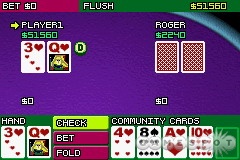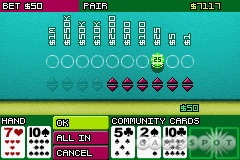Poker has soared in popularity in recent years thanks to the preponderance of televised tournaments. To capitalize on the craze, Majesco has released Texas Hold 'Em Poker, a Game Boy Advance game that's entirely focused on one of the more popular poker variations. It gets the sit-down experience right, especially with regard to computer-controlled personalities, but, between the game's bare-bones presentation, the complete lack of multiplayer modes, as well as a few other problems, it probably isn't going to become your main outlet for poker practice.

For those of you unfamiliar with Texas Hold 'Em Poker, the rules are deceptively simple. Each player at the table is dealt two cards facedown. These are called "hole cards." After an opening round of betting, the dealer tosses three cards faceup onto the table. This is called the "flop." Another round of betting occurs. The dealer then places another card onto the table, called the "turn." Again, a round of betting. After that, the dealer places a fifth and final card onto the table, which is called the "river." The goal of the game is to make the best hand of five cards by combining your hole cards with the community cards that the dealer deals. Theoretically, you can lure other players into betting or trick them into thinking you have better cards than you actually do by managing the way you bet.
Texas Hold 'Em Poker for the GBA includes two modes: quick play and career. Both modes let you join in during an in-progress cash game or enroll in a high-stakes tournament where the winner takes all. The main difference between the quick play and career modes is that the game keeps track of your winnings and rank in the career mode, and it starts you out in smaller casinos before letting you move onto the high rollers. There are multiple bet limits--$5/$10, $10/20, $20/$40, $40/$80, and so on--up to no limit, a style of hold 'em that allows you to bet your entire chip stack at any time. Unfortunately, the cartridge doesn't feature any multiplayer modes, which is a shame considering that poker is a highly social game, but then again, a deck of cards travels just about as easily as a GBA does.
Just like the actual sit-down game, the video game is easy to play and the CPU shows a goodly amount of skill. When your turn comes around, a menu lets you bet, raise, or fold. The game points out at the top of the screen whether you have a high card, pair, straight, or other worthwhile hand. You can also press the R button to toggle between a close-up view of your cards and a view that shows you how the entire table has bet (or folded). Each CPU player seems to be programmed with a unique personality, made evident by the number of bluffs and check raises that certain bots attempt hand after hand. The game also incorporates the use of forced blind bets, which cycle around the table and increase every few hands in order to keep the action going.
The biggest problem with the game is that the CPU makes up its mind too quickly. How much players bet and how quickly they do it says a lot about what kind of cards they have. The CPU in Texas Hold 'Em Poker for the GBA makes its decisions instantly, so you can't use speed as a predictor of someone's cards. Another gripe related to the CPU is that there are only 10 different opponents. It doesn't take long at all to figure out how one or two opponents react in certain situations, which ultimately gives you the upper hand going forward. The last nuisance worth mentioning is the game's save system, which is password based. Low-priced games rarely have automatic battery backups, but even so, 18 characters become a bit much to ask people to write down after every win.

Table games generally don't lend themselves to spectacular visuals or audio when they're turned into video games. That's very true here. There's just one table (with a variety of felt colors), one set of card backs, and no animation to speak of. Nonetheless, card symbols are easy to see and the layout of the table resembles what you'd find at an actual casino. The highlight of the audio is the speech clips that announce things like "the flop is," "the turn is," and "two pair takes the pot." Otherwise, the same background music plays constantly, and sound effects are limited to the shuffling of cards and the plinking of chips.
It's too bad Majesco didn't sign up a few actual poker stars to lend their names and likenesses to Texas Hold 'Em Poker. The meager presentation and the lack of multiplayer modes probably wouldn't have mattered so much if the game allowed players to take on the AI renditions of Doyle Brunson, Phil Hellmuth, Annie Duke, Daniel Negreanu, and others.
Overall, Texas Hold 'Em Poker for the Game Boy Advance is a no-frills rendition of today's most popular poker variation that might satisfy those looking for a generic, solo play experience, but the stripped-down contents of the game won't hold your attention for long.